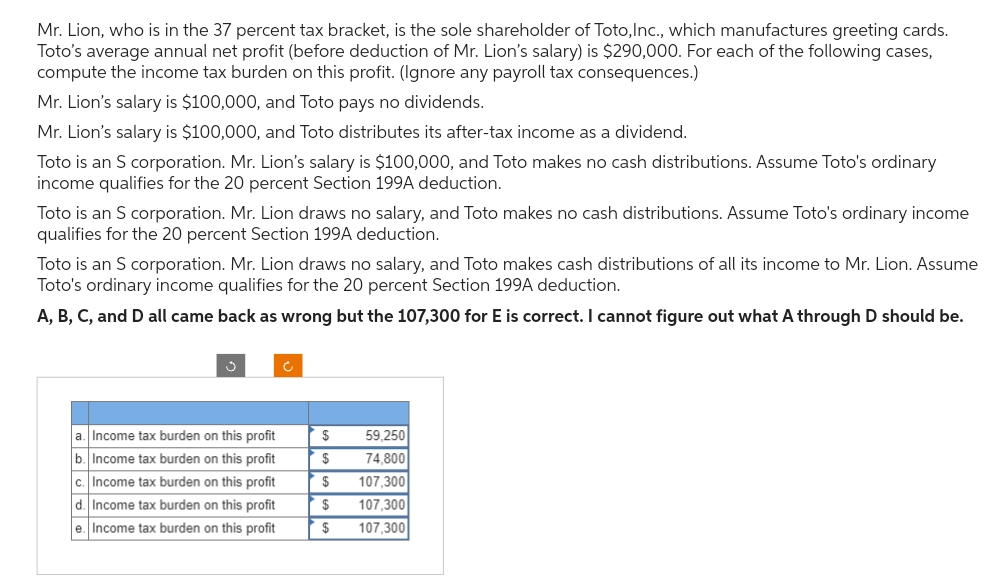Mr. Lion, who is in the 37 percent tax bracket, is the sole shareholder of Toto, Inc., which manufactures greeting cards. Toto's average annual net profit (before deduction of Mr. Lion's salary) is $290,000. For each of the following cases, compute the income tax burden on this profit. (Ignore any payroll tax consequences.) Mr. Lion's salary is $100,000, and Toto pays no dividends. Mr. Lion's salary is $100,000, and Toto distributes its after-tax income as a dividend. Toto is an S corporation. Mr. Lion's salary is $100,000, and Toto makes no cash distributions. Assume Toto's ordinary income qualifies for the 20 percent Section 199A deduction. Toto is an S corporation. Mr. Lion draws no salary, and Toto makes no cash distributions. Assume Toto's ordinary income qualifies for the 20 percent Section 199A deduction. Toto is an S corporation. Mr. Lion draws no salary, and Toto makes cash distributions of all its income to Mr. Lion. Assume Toto's ordinary income qualifies for the 20 percent Section 199A deduction. A, B, C, and D all came back as wrong but the 107,300 for E is correct. I cannot figure out what A through D should be. a. Income tax burden on this profit b. Income tax burden on this profit c. Income tax burden on this profit d. Income tax burden on this profit e. Income tax burden on this profit $ $ 59,250 74,800 $ 107,300 $ 107,300 $ 107,300
Mr. Lion, who is in the 37 percent tax bracket, is the sole shareholder of Toto, Inc., which manufactures greeting cards. Toto's average annual net profit (before deduction of Mr. Lion's salary) is $290,000. For each of the following cases, compute the income tax burden on this profit. (Ignore any payroll tax consequences.) Mr. Lion's salary is $100,000, and Toto pays no dividends. Mr. Lion's salary is $100,000, and Toto distributes its after-tax income as a dividend. Toto is an S corporation. Mr. Lion's salary is $100,000, and Toto makes no cash distributions. Assume Toto's ordinary income qualifies for the 20 percent Section 199A deduction. Toto is an S corporation. Mr. Lion draws no salary, and Toto makes no cash distributions. Assume Toto's ordinary income qualifies for the 20 percent Section 199A deduction. Toto is an S corporation. Mr. Lion draws no salary, and Toto makes cash distributions of all its income to Mr. Lion. Assume Toto's ordinary income qualifies for the 20 percent Section 199A deduction. A, B, C, and D all came back as wrong but the 107,300 for E is correct. I cannot figure out what A through D should be. a. Income tax burden on this profit b. Income tax burden on this profit c. Income tax burden on this profit d. Income tax burden on this profit e. Income tax burden on this profit $ $ 59,250 74,800 $ 107,300 $ 107,300 $ 107,300
Chapter19: Corporations: Distributions Not In Complete Liquidation
Section: Chapter Questions
Problem 49P
Related questions
Question
N1.
Account

Transcribed Image Text:Mr. Lion, who is in the 37 percent tax bracket, is the sole shareholder of Toto, Inc., which manufactures greeting cards.
Toto's average annual net profit (before deduction of Mr. Lion's salary) is $290,000. For each of the following cases,
compute the income tax burden on this profit. (Ignore any payroll tax consequences.)
Mr. Lion's salary is $100,000, and Toto pays no dividends.
Mr. Lion's salary is $100,000, and Toto distributes its after-tax income as a dividend.
Toto is an S corporation. Mr. Lion's salary is $100,000, and Toto makes no cash distributions. Assume Toto's ordinary
income qualifies for the 20 percent Section 199A deduction.
Toto is an S corporation. Mr. Lion draws no salary, and Toto makes no cash distributions. Assume Toto's ordinary income
qualifies for the 20 percent Section 199A deduction.
Toto is an S corporation. Mr. Lion draws no salary, and Toto makes cash distributions of all its income to Mr. Lion. Assume
Toto's ordinary income qualifies for the 20 percent Section 199A deduction.
A, B, C, and D all came back as wrong but the 107,300 for E is correct. I cannot figure out what A through D should be.
a. Income tax burden on this profit
b. Income tax burden on this profit
c. Income tax burden on this profit
d. Income tax burden on this profit
e. Income tax burden on this profit
$
59,250
$ 74,800
$ 107,300
$ 107,300
$
107,300
Expert Solution
This question has been solved!
Explore an expertly crafted, step-by-step solution for a thorough understanding of key concepts.
This is a popular solution!
Trending now
This is a popular solution!
Step by step
Solved in 3 steps

Recommended textbooks for you









Individual Income Taxes
Accounting
ISBN:
9780357109731
Author:
Hoffman
Publisher:
CENGAGE LEARNING - CONSIGNMENT